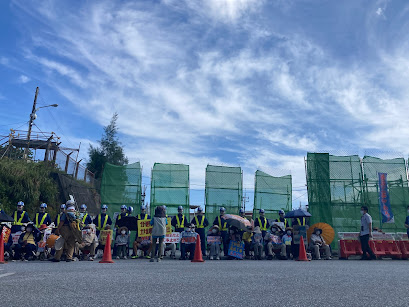Happy New Year!
New Year's Day has magical power. It helps us put our thoughts and spirits in a positive new light. It regenerates energy and power in our bodies and souls. And with our renewed eyes, we can see more clearly the importance of our environment and the need to protect it. This year, the Okinawa Environmental Justice Project is determined more than ever to protect the biodiversity-rich Henoko-Oura Bay and the Yambaru forest by "connecting the green dots." We are committed to being an agency to bring about positive changes in the interactions between environment protection, peace, and human rights.
New International Frameworks
This year, while continuing our humble efforts along the path of the last year, the Okinawa Environmental Justice Project incorporates in our efforts three international frameworks developed in the previous two years. In October 2021, the UN Human Rights Council adopted a resolution recognizing that the right to a clean, healthy and sustainable environment is a human right. In July 2022, the UN General Assembly adopted a similar resolution. And in December 2022, the Convention on Biological Diversity adopted the Kunming-Montreal Global Biodiversity Framework. This framework includes the Kunming-Montreal 2030 Global Targets; Target 3 calls for ensuring and enabling that "by 2030 at least 30 percent of terrestrial, inland water, and of coastal and marine areas, especially areas of particular importance for biodiversity and ecosystem functions and services, are effectively conserved and managed."
Futenma and Henoko-Oura Bay
The Okinawa Environmental Justice Project insists that the UNHRC and UN Resolutions apply to the PFAS contamination, noise pollution, and all other safety and health issues at the US Marine Corps Futenma Air Station and to the problems of environmental destruction and biodiversity loss at Henoko-Oura Bay. USMC Futenma Air Station violates the right of people living around the base to a clean, healthy, and sustainable environment. Delayed and long overdue, the airbase's closure must occur as soon as possible. As a first step, the designation of Futenma Air Station as a United Nations air base should be reviewed immediately. Meanwhile, the construction of the US military base at Henoko-Oura Bay utterly subverts the intentions of the Resolutions. The Japanese government's insistence that the base construction has not impacted the environment betrays the scientific foundations of these Resolutions. The base construction must stop immediately, and the environment of Henoko-Oura Bay must be saved. We will best use the international human rights frameworks to seek environmental justice at Futenma and Henoko-Oura Bay.
Henoko-Oura Bay and Yambaru Forest
OEJP insists that the CBD's 2030 Global Targets apply to Henoko-Oura Bay and the Yambaru forest. Recognized as a Hope Spot in 2019 by Mission Blue, the coastal area of Henoko-Oura Bay is one of Japan's most affluent biodiversity areas. It is not a place for military base construction; it is a place for environmental conservation. It should be included in the CBD's 30 percent protected coastal and marine areas. The area damaged so far by base construction should be restored following Target 2, which calls for ensuring that "by 2030, at least 30 percent of areas of degraded terrestrial, inland water, and coastal and marine ecosystems are under effective restoration, in order to enhance biodiversity and ecosystem functions and services, ecological integrity and connectivity." Also, the entire Yambaru forest, of which a good portion is a UNESCO World Natural Heritage site, should be included in the 30 percent terrestrial protected area. The US military's Northern Training Area, which sits next to the UNESCO Heritage site in the forest (see p69-71 of the World Heritage Watch Report 2022), should be returned to Okinawa/Japan and become part of the 30 percent protected area. Military training that impacts the biodiversity of the UNESCO World Heritage site must stop immediately. We will use the Kumming-Montreal Targets to protect Henoko-Oura Bay and the Yambaru forest.
Moving forward in 2023, we appreciate your continuing collaboration with and support for the Okinawa Environmental Justice Project. Thank you!
Hideki Yoshikawa
Director
Okinawa Environmental Justice Project




